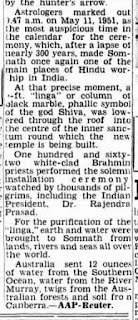This story is set in 1951, the year when the temple was reconsecrated. Several months before the installation of the lingam at the temple on May 11, 1951, the chief of the temple trustees started sending letters to India’s embassies abroad for contributions of water and twigs from all corners of the world.
Digvijaysinghji, the temple trust’s chairman, was also the Jam Saheb of Navanagar and Rajpramukh (titular head) of Saurashtra state. His quasi-official designation left Indian diplomats in a quandary. Prime Minister Nehru, a staunch secularist, repeatedly expressed his displeasure over such demands being made upon embassy officials, but he was unable to stop the flow of waters to India “from all seven oceans of the world.”
On April 17, Nehru wrote a letter to K M Munshi, the man who had been steering the temple’s reconstruction after Sardar Patel’s death.
“My dear Munshi, our ambassador in Peking writes to me that he has received a letter from the trustees of the Somnath temple asking the Embassy to collect and send waters from the Hoang Ho, the Yangtse and the Pearl rivers and also some twigs from the Tien Shan mountains. It was stated that this was necessary for the reconsecration of the Somnath temple…”
The Mercury, published from Hobart, reported on March 7, 1951:
“A request from India for 12 ounces of water from the Southern Ocean at Hobart Town has been received by the Tasmanian branch president of the United Nations Association (Mr J B Piggott). The water — sealed in a special container — was airmailed from Hobart yesterday.
Well, that’s how much 12 ounces is:
“Other things needed for the ceremony are: 12 oz of water from the Murray river, 1/4 pound of a few twigs of any species of vegetation from the Australian Alps, and 1/4 pound of soil from Canberra,” The Mercury said.
From New Zealand came “water from Auckland Harbour, twigs from the Southern Alps, and soil from Wellington… for this ceremony water, flora and soil were required not only from the sacred places in India, but also water from the seven traditional oceans of the world, and soil and flora from distant lands.”
A week after the ceremony, The Chronicle of Adelaide reported that more than 100,000 pilgrims from all over India had come to see it. “Astrologers marked out 9.47am on May 11, 1951, as the most auspicious time in the calendar for the ceremony… At that precise moment a linga or column of black marble was lowered through the roof into the centre of the inner sanctum round which the new temple is being built.” It must have been quite a spectacle.
***









